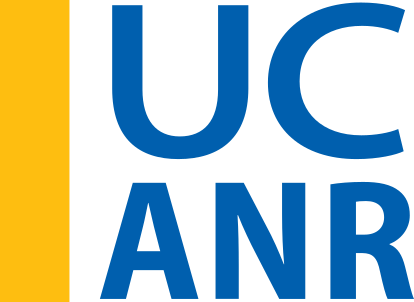- Author: Kathy Keatley Garvey
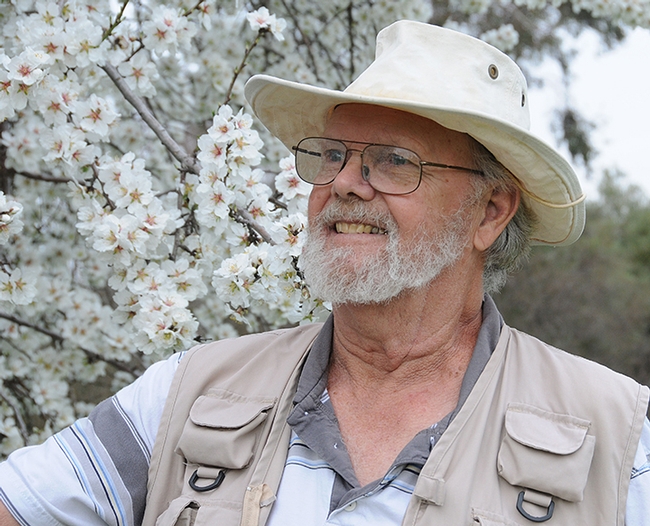
“He received what is perhaps the greatest honor one can receive from close colleagues, a special symposium honoring him and his contributions to the field of bee biology and pollination,” said coordinator and pollination ecologist Neal William, professor of entomology, UC Davis Department of Entomology and Nematology. Several of the leading bee biologists in western North America assisted with the symposium.
“It was known as The Robbin Symposium and colleagues old and new gathered the hear a supercharged line up present current research that has been directly impacted by Robbin Thorp,” Williams said. "We designed the symposium to honor the impact of Dr. Thorp, on the field of bee biology and conservation, but at the same time present innovative research that brings together bee and pollination biology researchers."
The symposium featured scientific contributions from leaders in the fields of bee ecology, conservation and pollination, all who worked with or were influenced by Thorp:
- Claire Kremen, University of British Columbia, formerly of UC Berkeley
- James Strange, USDA's Agricultural Research Service Heidi Dobson, Whitman College, Walla Walla, Wash.
- Gretchen Lebuhn, San Francisco State University
- Richard Hatfield, Xerces Society for Invertebrate Conservation
- Terry Griswold, USDA's Agricultural Research Service
- Neal Williams, UC Davis
- Leslie Saul-Gershenz, UC Davis
- Gordon Frankie, UC Berkeley
Hatfield, a senior conservation biologist with Xerces' Endangered Species Program presented him with a drawing of Bombus franklini, the work of artist April Coppini of Portland, Ore. An authority on Franklin's bumble bee, Thorp has monitored the bumble bee population since 1998 in its narrow distribution range of southern Oregon and northern California. He has not seen it since 2006 and it is feared extinct. In August of 2016 a documentary crew from CNN, headed by John Sutter followed him to a meadow where Thorp last saw Franklin's bumble bee. He wrote about Thorp, then 82, in a piece he called "The Old Man and the Bee," a spinoff of Ernest Hemingway's "The Old Man and the Sea." (See more on Franklin's bumble bee at https://xerces.org/franklins-bumble-bee/)
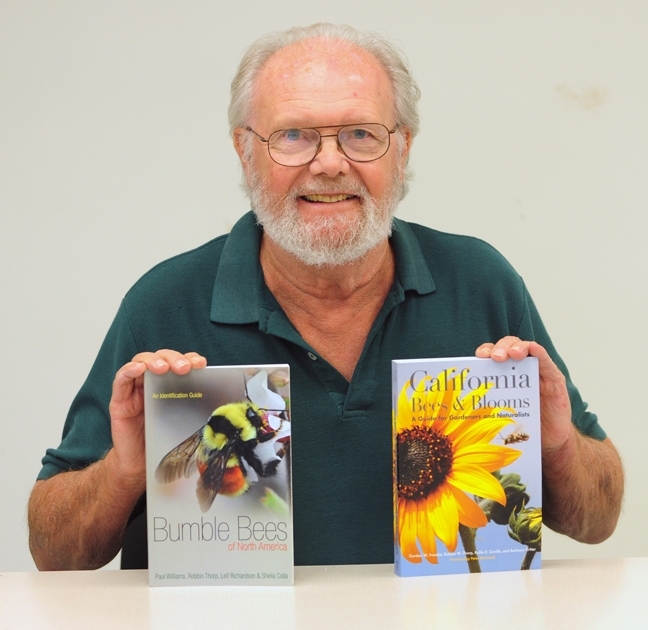
“Robbin has done so much for me over the years,” Hatfield said. “I'm pleased to give back even a small fraction.” Hatfield blogged about him during Earth Week. https://xerces.org/2019/04/24/robbin-thorp-earth-week/.
At the social event that followed, attendees shared their gratitude with Thorp "for his lifetime of work, mentoring and friendship,” Williams said.
"It was great to see Robbin interacting and enjoying the conference and the company," Frankie said. "We all have learned much from him over the years, and this was a good occasion to say thanks and acknowledge Robbin's many contributions."
Thorp, a member of the UC Davis entomology faculty for 30 years, from 1964-1994, achieved emeritus status in 1994 but has continued to engage in research, teaching and public service. In his retirement, he co-authored two books Bumble Bees of North America: An Identification Guide (Princeton University, 2014) and California Bees and Blooms: A Guide for Gardeners and Naturalists (Heyday, 2014).
A tireless advocate of pollinator species protection and conservation, Thorp is known for his expertise, dedication and passion in protecting native pollinators, especially bumble bees, and for his teaching, research and public service. He is an authority on pollination ecology, ecology and systematics of honey bees, bumble bees, vernal pool bees, conservation of bees, contribution of native bees to crop pollination, and bees of urban gardens and agricultural landscapes. He is active in research projects and open houses at the Bohart Museum of Entomology.
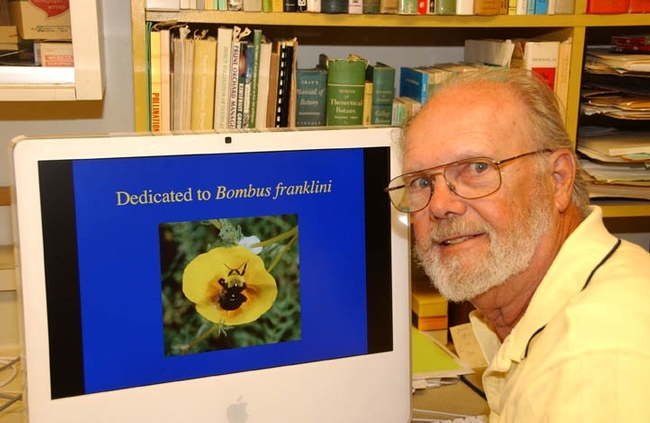
Every summer from 2002 to 2018, Thorp volunteered his time and expertise to teach at The Bee Course, an annual workshop sponsored by the American Museum of Natural History and held at the Southwestern Research Station, Portal, Ariz. The intensive 9-day workshop, considered the world's premiere native bee biology and taxonomic course, is geared for conservation biologists, pollination ecologists and other biologists who want to gain greater knowledge of the systematics and biology of bees.
Thorp was named a fellow of the California Academy of Sciences, San Francisco in 1986; recipient of the Edward A. Dickson Emeriti Professorship of UC Davis in 2010; and recipient of the UC Davis Distinguished Emeritus Award in 2015. Other honors include: member of the UC Davis Bee Team that won PBESA's Team Award in 2013. In addition, he is a past president (2010-2011) of the Davis Botanical Society, and former chair (1992-2011) of the Advisory Committee for the Jepson Prairie Reserve, UC Davis/Natural Reserve System.
Since its inception, Thorp has been involved in the Häagen-Dazs Honey Bee Haven, a half-acre bee garden on Bee Biology Road operated by the UC Davis Department of Entomology and Nematology, installed in 2009. To establish a baseline, he began monitoring the site for bees in 2008. He has since detected more than 80 species of bees.
In a letter of support for his nomination as distinguished emeritus professor,Kremen wrote:
"I have had the privilege of working with Dr. Thorp as a close colleague since 1999. I can definitely say that without his contributions, I could never have developed as extensive and impactful a research program on pollinator conservation and pollination services. It is even more noteworthy that Dr. Thorp's contributions to this research program have all occurred since his 'retirement'– he has had a very active retirement indeed."
"Dr. Thorp has contributed in three main ways. First, he has provided expert input into the design of protocols for the research, including assays for pollinator effectiveness, developing citizen science methods, rearing experimental bumble bee colonies, monitoring bumble bee colony properties in the field, and developing pollinator survey methods. Second, he has provided expert taxonomic services, including personally identifying over 100,000 native bee specimens that we have collected during this work, and working with us to develop a bee traits database. Third, he has trained numerous field assistants and graduate students from my lab in different aspects of bee biology. He's spent long hours with many of my graduate students helping them learn to identify bees. He also helped us develop methods and information sheets for teaching field and lab teams to recognize key generic and family characters for identifying bees in the field and sorting them in the lab. He's advised many of my graduate students on different aspects of their work.
"Collectively, Dr.Thorp's contributions have impacted 35 publications that have emerged from this research program to date, with many more either submitted or nearing the submission stage. He has also been a co-author on a number of these publications. Not only has Dr. Thorp had such a significant effect on the work of my lab, but he conducts his own primary work documenting the status of rare bumble bee species like Bombus franklini and B.occidentalis and contributes at a similar level to other research labs such as with his long-time collaborators Dr. Gordon Frankie and Dr. Neal Williams. It's really quite amazing how he manages to do it all."
"He also teaches regularly in The Bee Course, a field course held in Arizona each year by the American Museum of Natural History, frequently gives talks and workshops that educate our state agencies and the public about the importance of pollinators, and works with conservation organizations like the Xerces Society to promote pollinator conservation."
In another letter of support, Ullmann, director of the UC Davis Student Farm, Agricultural Sustainability Institute, who received her doctorate in entomology from UC Davis, wrote:
"I met Robbin Thorp in 2007 and assumed that he was an active professor because of his continued contribution to the field of entomology, teaching activities, publishing in peer-reviewed journals and vocal support of pollinator conservation efforts. For these reason I considered asking if I could join his lab. I remember telling someone my plan and they said 'That probably won't work. Robbin is retired.' He does so much in the field of pollination ecology that I didn't even realize he was retired.
"Since then I've had the privilege of interacting with Robbin as a field technician, a graduate student in the Department of Entomology at UC Davis, a student at The Bee Course, a co-presenter at a bee identification course for US Forest Service staff, and as a co-author on a peer-reviewed paper. The entire time that I've known Robbin I've been impressed with (1) his depth and breadth of knowledge about bees and crop pollination, (2) his willingness to share what he knows, and (3) how approachable he is. It doesn't matter if you're a MacArthur Genius or a field technician just learning about bees, Robbin always makes time to talk with you and answer your questions.
"Robbin is one of the few people in North America who can identify bees down to the species level. As a result he's in high demand and has identified thousands of specimens for numerous lab groups since his retirement. However, he doesn't just identify the specimens. Instead, he's willing to patiently work through dichotomous keys with you so that you can learn those skills."
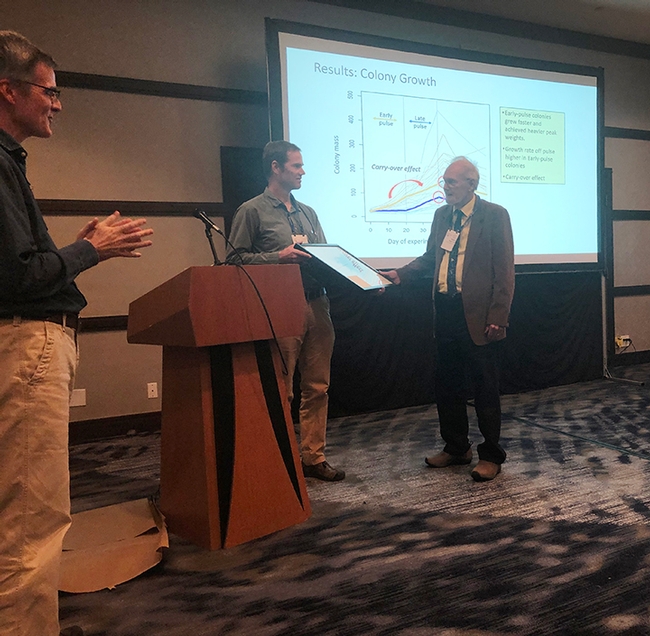
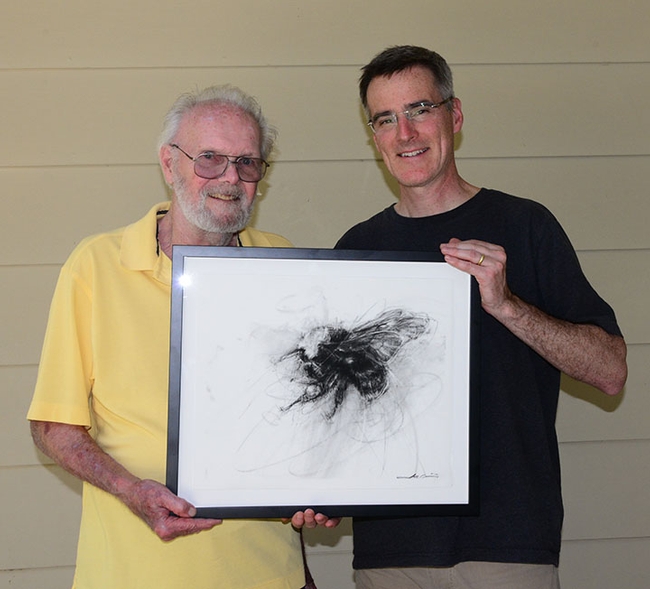
- Author: Kathy Keatley Garvey

Pollination ecologist Neal Williams, UC Davis Department of Entomology and Nematology professor, is organizing and chairing the symposium, which is scheduled for Tuesday afternoon, April 2 in the Hyatt Regency Mission Bay Spa and Marina.
“The symposium will include scientific contributions from leaders in the fields of bee ecology, conservation and pollination,” announced Williams. “All are individuals whose work and specialty have been influenced by Robbin and his research program."
The scientists speaking, in addition to emcee Williams, include:
- Claire Kremen, University of British Columbia, formerly of UC Berkeley
- James Strange, USDA's Agricultural Research Service
- Heidi Dobson, Whitman College, Walla Walla, Wash.
- Gretchen Lebuhn, San Francisco State University
- Richard Hatfield, Xerces Society for Invertebrate Conservation
- Terry Griswold, USDA's Agricultural Research Service
- Leslie Saul-Gershenz, UC Davis
- Gordon Frankie, UC Berkeley
“The symposium will be followed by a social time during which hope to share our gratitude with Robbin for his lifetime of work, mentoring and friendship,” Williams said.
Thorp, a member of the UC Davis entomology faculty for 30 years, from 1964-1994, achieved emeritus status in 1994 but has continued to engage in research, teaching and public service. In his retirement, he co-authored two books Bumble Bees of North America, an Identification Guide (Princeton University, 2014) and California Bees and Blooms, A Guide for Gardeners and Naturalists (Heyday, 2014).
Thorp, a tireless advocate of pollinator species protection and conservation, is known for his expertise, dedication and passion in protecting native pollinators, especially bumble bees, and for his teaching, research and public service. He is an authority on pollination ecology, ecology and systematics of honey bees, bumble bees, vernal pool bees, conservation of bees, contribution of native bees to crop pollination, and bees of urban gardens and agricultural landscapes. He is active in research projects and open houses at the Bohart Museum of Entomology.
Thorp received his bachelor of science degree in zoology (1955) and his master's degree in zoology (1957) from the University of Michigan, Ann Arbor. He earned his doctorate in entomology in 1964 from UC Berkeley, the same year he joined the UC Davis entomology faculty. He taught courses from 1970 to 2006 on insect classification, general entomology, natural history of insects, field entomology, California insect diversity, and pollination ecology.
Every summer since 2002, Thorp has volunteered his time and expertise to teach at The Bee Course, an annual workshop sponsored by the American Museum of Natural History and held at the Southwestern Research Station, Portal, Ariz. The intensive 9-day workshop, considered the world's premiere native bee biology and taxonomic course, is geared for conservation biologists, pollination ecologists and other biologists who want to gain greater knowledge of the systematics and biology of bees.
An authority on Franklin's bumble bee, Bombus franklini, Thorp has monitored the bumble bee population since 1998 in its narrow distribution range of southern Oregon and northern California. He has not seen it since 2006 and it is feared extinct. In August of 2016 a documentary crew from CNN, headed by John Sutter followed him to a meadow where Thorp last saw Franklin's bumble bee. He wrote about Thorp, then 82, in a piece he called "The Old Man and the Bee," a spinoff of Ernest Hemingway's "The Old Man and the Sea."
Thorp was instrumental in placing the bumble bee on the Red List of Threatened Species of the International Union for Conservation of Nature and Natural Resources (IUCN). Long active in the North America IUCN Bumblebee Specialist Group, Thorp served as its regional co-chair, beginning in 2011.
Thorp was named a fellow of the California Academy of Sciences, San Francisco in 1986; recipient of the Edward A. Dickson Emeriti Professorship of UC Davis in 2010; and recipient of the UC Davis Distinguished Emeritus Award in 2015. Other honors include: member of the UC Davis Bee Team that won PBESA's Team Award in 2013. In addition, he is a past president (2010-2011) of the Davis Botanical Society, and former chair (1992-2011) of the Advisory Committee for the Jepson Prairie Reserve, UC Davis/Natural Reserve System.
Since its inception, Thorp has been involved in the Häagen-Dazs Honey Bee Haven, a half-acre bee garden on Bee Biology Road operated by the UC Davis Department of Entomology and Nematology, installed in 2009. To establish a baseline, he began monitoring the site for bees in 2008. He has since detected more than 80 species of bees.
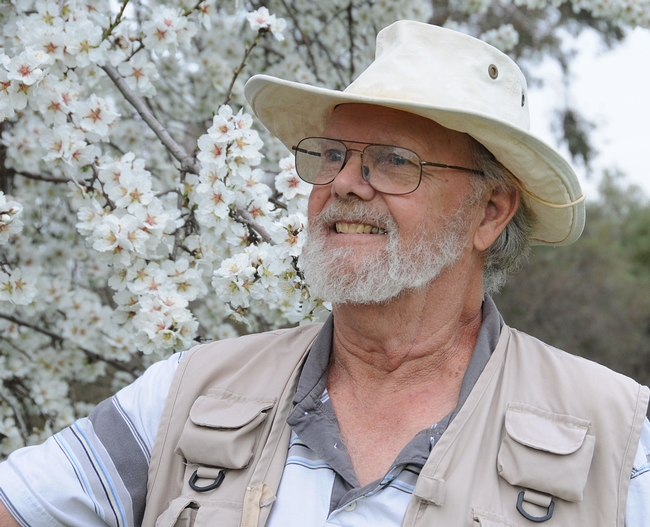
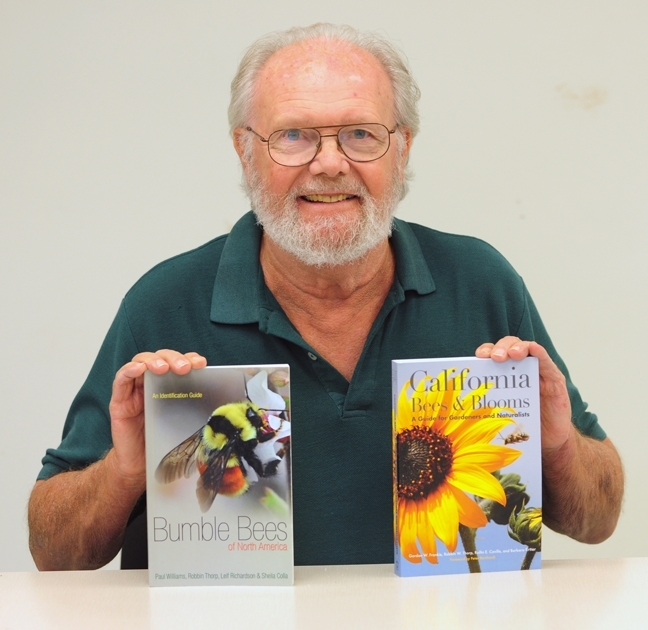
- Author: Kathy Keatley Garvey
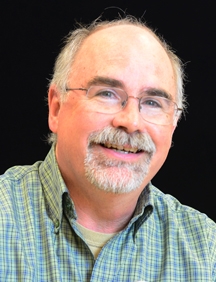
Lewis is recognized as a global leader in using nematodes as biological agents, said nematologist Steve Nadler, professor and chair of the UC Davis Department of Entomology and Nematology.
Lewis will receive the award at PBESA's 100th annual meeting, “Science for the Next Century,” set April 3-6 in Honolulu. PBESA is comprised of 11 western states: Alaska, Arizona, California, Hawaii, Idaho, Montana, Nevada, Oregon, Utah, Washington, Wyoming), parts of Canada and Mexico, and seven U.S. territories.
Lewis is now an applicant for the national IPM award, to be presented by ESA at its September meeting in Orlando, Fla.
IPM specialist Frank Zalom, UC Davis distinguished professor of entomology and a past president of the 7000-member Entomological Society of America, praised “Ed's outstanding contributions to our state, national and global agricultural research.”
“Ed's work involves five of our state's 10 most valued commodities: almonds, a $5.9 billion crop, strawberries, $2.5 billion; walnuts, $1.8 billion; tomatoes, $1.6 billion and pistachios, $1.6 billion (2014 statistics),” said Zalom, a past recipient of the Pacific Branch and national IPM awards. “Also in 2014, California's agricultural exports amounted to $21.59 billion in value. Thus, in many respects, California feeds the world, and Ed's research is integral to controlling insects and nematodes.”
“Dr. Lewis has one of the most diversified research programs that I have known,” Nadler said. “He collaborates regularly with many different constituencies ranging from small startup companies to various commodity boards in order to take information from basic laboratory research and apply it to field situations. What ties together many of these projects is biological control of pest organisms with a focus on sustainability and integrated pest management.”
“Dr. Lewis' lab has been instrumental in using entomopathogenic nematodes (EPNs) to implement biological control of a large variety of insect pests,” Nadler pointed out. “His research with these nematodes has focused on investigating the ecological factors that relate to host-finding, persistence in soil, and their efficacy in field situations.”
In addition to understanding factors that influence nematode success, the Lewis laboratory “has worked to understand how other approaches, such as novel fertilizers, can work in combination to increase plant productivity,” Nadler said.
“Few scientists working with EPNs have designed and implemented such detailed and relevant studies to characterize what happens to nematodes under field conditions,” Nadler noted. “Importantly, use of EPNs to control naval orangeworm is effective and can reduce the need for pesticide applications.”
Research entomologist David Shapiro-Ilan of the USDA's Agricultural Research Service said that Lewis' research has “contributed immensely to the disciplines of entomology and IPM.”
“Dr. Lewis has clearly emerged as a world leader in research and application of entomopathogenic nematodes or EPNs,” said Shapiro-Ilan.
A native of New York, Lewis received his doctorate in entomology in 1991 from Auburn (Ala.) University and then accepted postdoctoral positions at Rutgers University and the University of Maryland. He then moved to Virginia Tech to join the entomology faculty there.
Lewis joined the UC Davis faculty in 2004. He serves as the editor-in-chief of the Elsevier journal Biological Control. He is also known for teaching two highly popular classes at UC Davis: “Behavioral Ecology of Insects” and “Biological Control of Agricultural Pests.”
- Author: Kathy Keatley Garvey
DAVIS--UC Davis undergraduate entomology researcher Jadrian Ejercito of the Shirley Luckhart lab won second place in the highly competitive student poster competition at the 99th annual meeting of the Pacific Branch of the Entomological Society of America (PBESA), held recently in Coeur d'Alene, Idaho.
His poster, on a malaria mosquito, was titled “Effects of Abscisic Acid on the Lifespan and Fecundity of Anopheles stephensi.” Ejercito was the only UC Davis entomology student to win a poster award.
For the project, he collaborated with his mentor, Shirley Luckhart, a professor in the Department of Medical Microbiology and Immunity and co-director of the Center for Vectorborne Diseases; and doctoral candidate Elizabeth Glennon of the Luckhart lab.
Judges scored the poster on 12 criteria, including abstract, presentation, introduction, objectives, results and discussion, and significance of the results.
Ejercito, a senior scheduled to receive his bachelor's degree in entomology in June, works in the Luckhart main lab as well as the Contained Research Facility.
A graduate of Nathaniel A. Narbonne High School in Harbor City, Los Angeles County, Ejercito joined the Luckhart lab as a MURALS scholar, a program dedicated to supporting undergraduate researchers. MURALS is an acronym for “Mentorship for Undergraduate Research in Agriculture, Letters an Science.” Formed in the spring of 1988, under the sponsorship of the Office of Student Affairs and the academic leadership of the College of Letters and Science, MURALS now includes students from all academic disciplines. Its mission is to encourage students to further their education beyond the baccalaureate.

- Author: Kathy Keatley Garvey
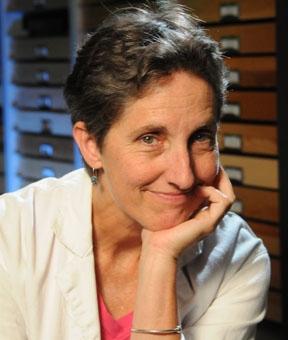
Kimsey will receive the award at the 98th annual PBESA meeting, set for April 6-9 at the Marriott University Park, Tucson, Ariz. PBESA covers 11 western states (Alaska, Arizona, California, Hawaii, Idaho, Montana, Nevada, Oregon, Utah, Washington and Wyoming), parts of Canada and Mexico and seven U.S. territories.
In nominating her for the award, her colleagues noted that Kimsey excels at research, teaching, and public service. “There are not many entomologists who can match her expertise, general knowledge, curiosity, and enthusiasm about insects, discovered and undiscovered, or her specific knowledge about the aculeate wasp families, Chrysididae and Tiphiidae,” they pointed out in the nomination package. Chrysidids affect predator and pollinator populations, and tiphiids directly affect immature populations of Japanese beetles and 10-lined June beetles.
Quentin Wheeler, president of the College of Environmental Science and Forestry, State University of New York, praised her as a "widely recognized as a taxonomist of high international stature" who has "achieved notable excellence in systematics, evolution and biodiversity."
Known fondly by her colleagues as “The Wasp Woman,” Kimsey is one of only a few scientists in the world who can identify chrysidid or tiphiid wasps to species. Species discovery is a larger part of her research because only an estimated 60 percent of these species are known. To date, Kimsey has named 250 new species and 17 new genera.
Kimsey focuses her research on four areas of systematics: monography and species discovery, phylogeny and biogeography. Most of her research projects are long-term, requiring the examination of large numbers of museum specimens, development and analysis of data sets, field collecting, and location and analysis of older literature.
Kimsey's primary research focuses on resolving global patterns of evolution in the wasp family Tiphiidae, which includes eight subfamilies. A second project is to understand the insect diversity of California and how it fits into local and global patterns of biodiversity. In 2001 Kimsey brought the California Insect Survey (CIS) to UC Davis, and is now editor of the Bulletin of the California Insect Survey. Her more than 100 peer-reviewed publications include books on chrysidid cuckoo wasps of North America and the world. She published one book through this series on “California Cuckoo Wasps in the Family Chrysididae (Hymenoptera)” and is editing a second book on the forensically important flies of California (with Michael Niemela).

Kimsey built the Bohart Museum of Entomology into a world-class museum; today it houses a global collection of nearly eight million insect specimens in its quarters in 1124 Academic Surge on Crocker Lane, UC Davis campus. It is the seventh largest insect museum in North America and the home of the California Insect Survey. The museum also is the home to a live “petting zoo” (Madagascar hissing cockroaches, walking sticks, praying mantids, tarantulas) and a gift shop.
Said ESA Fellow Robert Washino, UC Davis emeritus professor of entomology, former department chair and former associate dean who has known Kimsey for 40 years: “When the existing museum facility became inadequate early in her career, to sustain a dynamic teaching, research and public service program for her as well as her colleagues, she took it upon herself to obtain a major extramural grant from the National Science Foundation that required matching funds from the campus administration--rare indeed!--for relocation and modernization of the museum facilities. This involved the purchase and installation of new ‘state of the art' movable shelves to accommodate and store insect collections that made possible the necessary expansion to the UC Davis insect repository one of the major facilities in the U.S."
Kimsey spearheaded the purchase and installation of new “state of the art” movable shelves to accommodate and store insect collections. The museum is open to the public from Monday through Friday and on many weekends or special open houses. She provides scores of educational activities for the public. The museum draws more than 15,000 children per year to the museum. Another new project is the campuswide UC Davis Biodiversity Day, which involves six biological museum (including the Bohart Museum) opening their doors to the general public on an afternoon in February.
Dr. Kimsey also runs an information service on delusional parasitosis to serve the public and medical community. This information is used as the gold standard by the Centers for Disease Control and Prevention.
Kimsey received her doctorate in entomology in 1979 from UC Davis and joined the entomology faculty in 1989, after serving as a visiting professor/lecturer at the Museum of Comparative Zoology, Harvard University.
Known for her broad interest in the systematics of insects, not just in one order, family, genus or species, Kimsey is eager to collect new specimens for the museum, her colleagues said. “When she collects, she wants them all,” said Bohart Museum senior scientist and colleague Steve Heydon. “When Lynn goes collecting, she puts up Malaise traps, pan traps, light traps, the whole works, and so the Bohart collection grows in diversity of all the orders instead of just a few.”
Kimsey answers thousands of insect questions a year and is “go-to” person when members of the news media want to know about insects. Among the hundreds of news media interviews: she has appeared on ABC, NBC, CBS, BBC and National Public Radio, provided information to the TV show, Fear Factor. She s continually featured in metropolitan newspapers, including the Los Angeles Times, National Geographic and Sacramento Bee. Kimsey drew international attention in a homicide trial when she identified insects from the grill of a car to specific geographical locations.
Kimsey sparks, inspires and motivates her students in her Entomology 100 and 1001 classes. As one student wrote, “She is a great professor and made the topic very fun. She is very understanding and compassionate.” Another said: “She doesn't make you feel bad for asking dumb questions, she's funny, and even will chat with students for fun. Field trips are really fun, too. Besides, you know you wanna take a class when you get to swing giant bug nets around.”
Kimsey's teaching ranges from undergraduate and graduate level courses to public educational programs for K-12 aged children via the Bohart Museum and specialized training workshops. She teaches a public speaking class for graduate students. She is one of the three founding instructors of the One Minute Entomology course, which involves undergraduates researching and creating a one-minute video on an insect or arthropod.
Kimsey, former vice chair and interim chair of the Department of Entomology, serves as the executive director of the Bohart Museum Society, a community support group for the museum; founder and director of the Center for Biosystematics at UC Davis; and head of informal campus groups, the Association of Biological Collections and Biodiversity Consortium.
Former Kimsey graduate student Michael Niemela, now a senior public health biologist for the Vector –Borne Disease Section, California Department of Public Health, said “Dr. Kimsey's ability to mentor and motivate students has advanced the careers and enriched the professional lives of not only her past and present graduate students, but countless undergraduate students who have interacted with her through lecture or visits to the Bohart Museum of Entomology. Dr. Kimsey has been a prodigious author throughout her career, with 103 refereed publications, 14 limited publications and 44 Bohart Museum Society newsletters. Since 1984, she has been the recipient of 25 grants, most recently for insect surveys in Indonesia and for databasing North American bee collections within a global informatics network. Notable among her accomplishments are her many contributions to the field of insect systematics and evolution. Dr. Kimsey has published an extensive number of papers focusing on insect behavior and biology. However, she is known more for her systematic work. Beginning with her 1974 review of Mellinus wasps, Dr. Kimsey has published at least 70 papers focused on the description of new species, generic reviews or familial phylogenetic revisions.”
